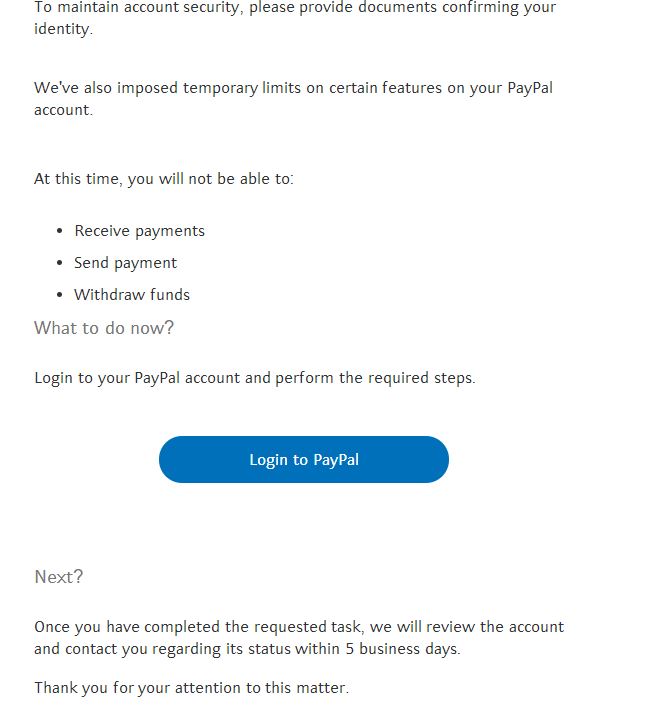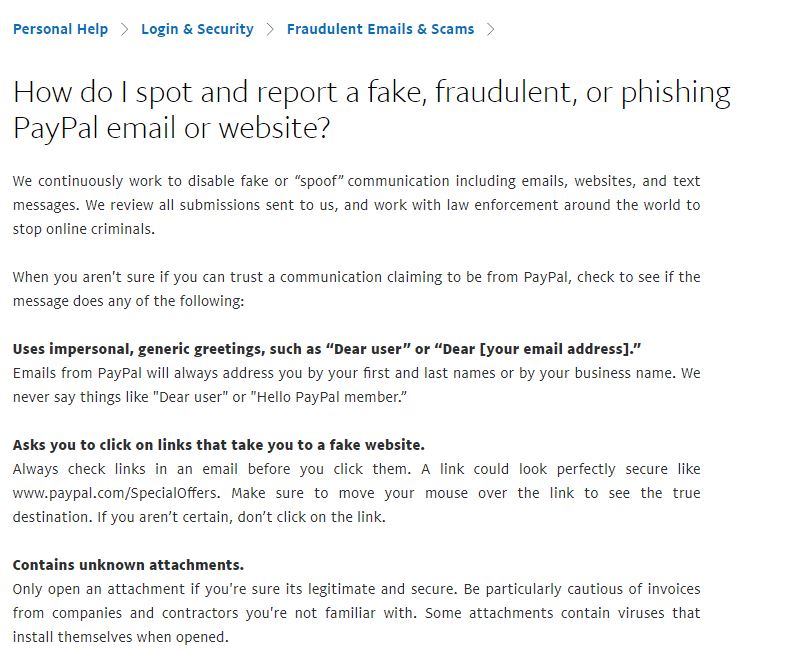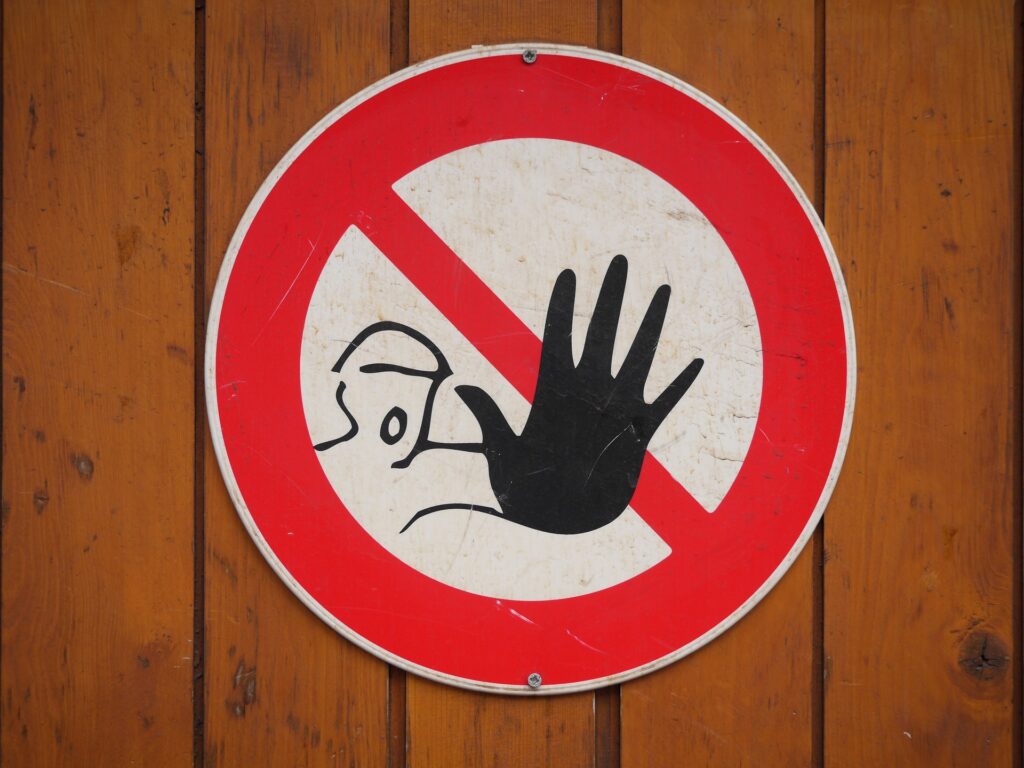Why is my PayPal Account Limited?
It has been awhile since I’ve talked about scams, especially those that come into your email inbox. Trust me, even though I’ve been quiet lately, that doesn’t mean I’ve stopped receiving scams. Quite the contrary, it seems like I have been receiving a lot more of them lately, especially those that say they are from PayPal and then causes me to ask “Why is my PayPal Account Limited?”.
We’re going to take a look at one that is fairly recent as the title of it says “PayPal Account Limited”. Should I panic and worry that something has really happened to my PayPal account or is it just scammers trying to scare me into giving away my account login credentials? Let’s take a closer look!
PayPal Account Limited
At first glance of the email, it looks like it could be a legitimate email from PayPal, but the subject line looks a little odd, as the font just seems to be a bit off. Is this something that PayPal typically does? Well, there are ways to distinguish a legitimate email from PayPal versus a fake one. The scary thing is though is that the fake emails at times are getting really good at looking like the real ones.
Now upon looking into the body of the email, it really looks like a legitimate email from PayPal. It has their logo and colors and a link that looks like it would be from them. At the beginning of the email it states that my PayPal account has been temporarily restricted.
Upon reading that, that would certainly cause alarm because I do at times have money coming in and out of my PayPal account and so any email coming from them saying that my account is being restricted would normally cause me to worry. Some accounts that I have with other companies are paid through my PayPal account and so I would not want anything to happen with it.
Going further into the email, it states why my account is being restricted. It says they supposedly found suspicious activity on a credit card that’s linked to my account. It says that they want me to confirm my identity to confirm that I’m the owner of the credit card. This is a MASSIVE red flag for me and I will tell you why here in a little bit. Continuing on, it says that I will not be able to receive payments, send payments, or withdraw funds. How do I remedy this? Well, it says for me to click the link below and log into my PayPal account to fix the issue.
What Happens When the Link is Clicked?
When these type of emails are received and after you read what the issue is about, there’s almost always a link included so that you can “fix” whatever issue has happened to your PayPal account. The question then becomes, what happens when the link is clicked? Well this is where things can get scary because what will happen is you’ll be taken to a site that will look practically identical to PayPal.
The problem is, it’s not PayPal at all and if you use your real login credential potentials to try to get into your account, you’ll have given scammers the keys to get into your real PayPal account that will cause problems for you because now they have access to whatever you use to send or receive money through PayPal which could be a debit card, credit card, or even bank account and they could drain all of that. The email says that there is suspicious activity to a credit card linked to my account. I will tell you that the reason this is a red flag for me, in terms of the email being fraudulent, is because I don’t have a credit card linked to my PayPal account.

I did click the link in this instance because I wanted to see what the scammer’s site looked like, but it looks like it has been taken down as it doesn’t lead to anyplace which is good. That means it’s more than likely been reported to PayPal themselves and they took action to get that scam site shut down.
Now I do have an example of what one of these scam sites looks like and it is downright scary because it so closely resembles PayPal’s actual login page and it would be understandable to see how someone could be fooled into thinking it is the real site. You can read the article and see an actual example by clicking here.
You should never click a link an email that you are unsure of as being legitimate because it will take you someplace that will try to steal your information and then real damage can be done. Are there ways to tell a legitimate PayPal email from a fake one? The answer is yes and I’ll go over that next.
What to look for in Phishing Emails
If you’re wondering of how you go about telling the differences between a legitimate email and a fake one, you’re in luck because I’m going to tell you how to do that. One of the things you’ll want to look at first is the subject line. Does the font look odd? If so, then that is your first sign that something is not quite right in this email. The email I received definitely has a strange looking font in the subject line so that is my first red flag that this email is a scam.
The second thing to look for is the email address that the email came from. A true email from PayPal will be short and will have @paypal.com as part of the email address. Anything else means it definitely did not come from PayPal or any other company it supposedly says it’s from. Trust me, PayPal isn’t the only company that scammers try to trick people into thinking it’s legitimate.
Now the email address that this email came from is definitely odd and pretty long. tlyykw3cocgs8bk-tfims8rpvs9z32rg@mail.com. Does that look like a legitimate email address to you? It’s nothing but a series of random letters and numbers and doesn’t seem to be from any legitimate email domain.
![]()
This will always be your biggest red flag, the email address. When you’re unsure of anything else, the email address will definitely let you know if you’ve come across a scam or not so always pay attention to that. It has saved me from becoming a victim to a number of different phishing email scams.
The next thing you’ll want to look for are spelling and grammatical errors. A lot of times scam emails will be filled with them, but I’m going to be honest with you here. The scammers are getting a lot better at reducing those type of errors so it does make it harder to figure out if the email is real or not. In the case of the email I did receive, I really couldn’t find much of anything in regard to spelling and grammar errors.
However, one thing I did notice is that the title of each different section of the email is a different color. The titles or subject are gray. It honestly doesn’t make any sense because it actually makes it a little harder to see and if something is truly wrong with your account, you want to keep the full attention of the reader and so you want to keep everything bold/dark against a white background. A legitimate email by PayPal would never do that so that is another clue for me that this email is a phishing scam.
Something else to keep an eye out on if you happen to click the link in the email (though I don’t ever suggest you do this), is to take a look at the url of the website it takes you to. Yes, the website itself might legitimately look like PayPal, but the url will truly give you the answer as to if it’s PayPal or not. The following is PayPal’s actual website address: https://www.paypal.com/us/home .
If you see a different url address, then immediately close down that internet browser tab because the website is truly not them. You’ll see an example of that if you clicked the link I posted earlier to my other article that shows a fake PayPal site. Still, you should never click a link in a suspected scam email because the site it takes you to could have malware or spyware on it that can make your computer vulnerable just by being on that scammer’s site. Is there anything else that can be done if you suspect an email is fraudulent? The answer is yes and I’ll go over that next.
Let PayPal Know
Believe it or not, you can let PayPal know if you suspect any emails to be fraudulent or claiming to be them. If you go to their website and click their section that says Help on their main menu, you’ll find a menu on the left side of the screen and you’ll want to click where it says Login & Security. You’ll then want to click on the section that says Fraudulent Emails & Scams and it’ll have a few common questions about receiving emails from PayPal.
There are a couple of them that you’ll want to click on such as “How do I spot and report a fake, fraudulent, or phishing PayPal email or website?” and “What are common scams and how do I spot them?“. Clicking on the first question will bring you to a very helpful page that lots of information on what to do if you receive a suspected fraudulent email.
One of the things they talk about that I haven’t mentioned is if you receive an email that has an attachment. You should never open an attachment from a suspected email because, just as PayPal says, it will more than likely contain a virus that can harm your computer.

Another good thing that they let you know about is if you ever suspect an email is fraudulent, they give you an address to forward the email to so they can take a look at it and take action against scammer websites that claim to be PayPal.
Something else that’s talked about here are suspicious phone calls. I haven’t really talked about this because I honestly haven’t received any phone calls claiming to be from PayPal and I take that as a good thing. I do ignore most phone calls though that I don’t recognize as I know there are a lot of fraudulent phone calls going around out there. I like that they tell you what can be done if you receive one of those deceiving phone calls.
Always be Vigilant
Now that you’ve seen what to look for in fraudulent PayPal emails, especially in the case of the one that I received, I no longer have to ask “Why is my PayPal Account Limited?”. I went over what to look for in a phishing email that will be major red flags for you.
You always want to be vigilant. Never let your guard down because these emails are designed to get you to panic and not think logically. They want you to click the link inside the email and go to their fake site so they can steal your login credentials and then start to do real damage.
If you truly suspect that something has happened to your PayPal account, all you have to do is open a separate browser and type in paypal.com which will take you to the real website and what will more than likely happen is when you login to your account, you’ll see that everything is fine. Never click the link inside the email.
I will talk about more phishing emails that I’ve received in the future. Some of them will be more fraudulent PayPal emails, but I also have a few others such as Netflix and Apple so stay tuned.

